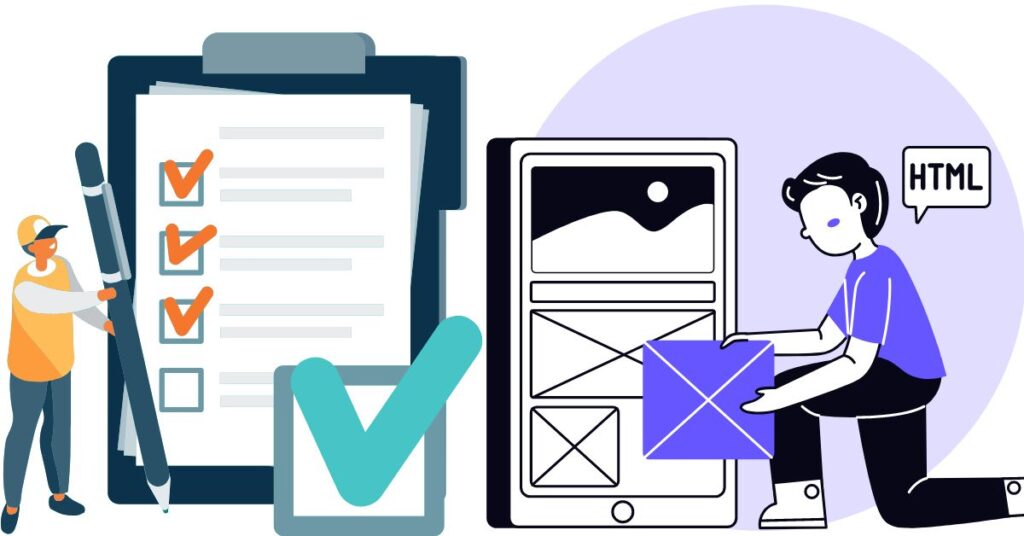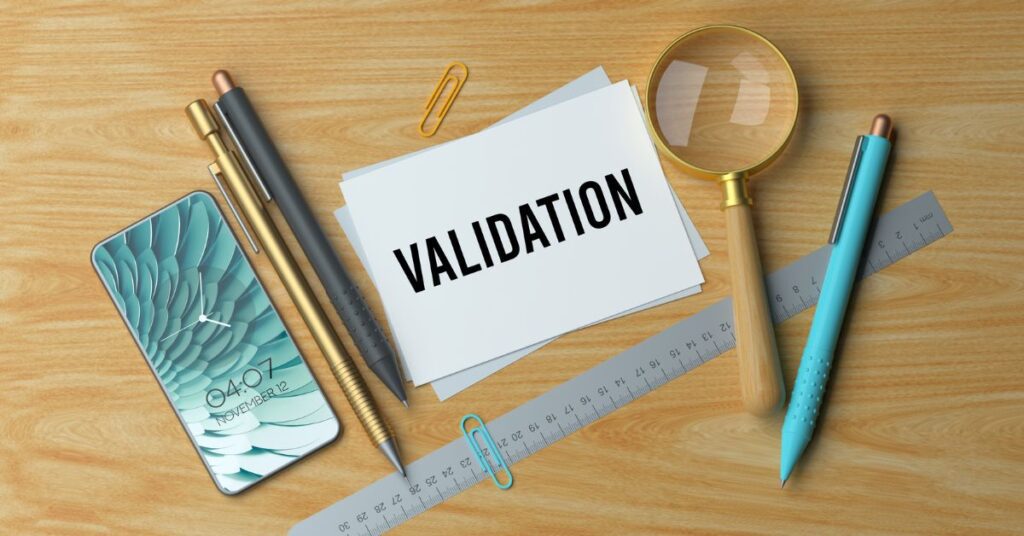Are you familiar with the term “product validation“? It’s a crucial step in developing and launching any new product, which we’ll discuss in this blog post.
So, what exactly is product validation? Simply put, it’s the process of testing and verifying whether a product idea is worth pursuing. This involves gathering feedback from potential customers, testing prototypes, analyzing results, and refining the product until it meets the target market’s needs.
Now, why is product validation so important? Well, it helps to minimize the risk of investing time and money into a product that ultimately fails in the market. By validating the product early on, you can identify and address any issues or concerns before the official launch. Product validation can also ensure that the product aligns with the target audience’s needs and preferences, ultimately leading to higher customer satisfaction and loyalty.
So, in this blog post, we’ll break down the product validation process into 6-8 steps. By the end of this post, you can expect to have a solid understanding of how to validate a product and the tools and resources needed.
Are you ready? Let’s dive in!

Step 1: Define the Problem – Product Validation
The first step in product validation is to define the problem your product solves. This is crucial because if your product doesn’t solve a real problem, it’s unlikely to be successful in the market. You need to clearly understand your target audience’s pain points and needs before you can create a product that addresses those needs.
You can use a few methods to identify the pain points of your target audience. One of the most effective ways is to gather customer feedback. This can be done through surveys, focus groups, or individual interviews. You can gain valuable insights into their needs and preferences by asking targeted questions about your target audience’s challenges and frustrations.
For example, let’s say you’re creating a fitness app targeted at busy professionals who want to stay healthy but struggle to find time for exercise. You might conduct a survey to ask questions like “What are your biggest challenges when it comes to staying fit?” or “What would make it easier for you to prioritize exercise in your daily routine?” The answers you receive can help you identify the specific pain points your target audience experiences and create a product that addresses those needs.
Another way to gather customer feedback is to observe their behavior. For example, if you’re creating a shopping app, you might watch how people currently shop online and identify any pain points in the process. This can help you create a product that makes the shopping experience more seamless and enjoyable.
Defining the problem your product solves is the first step in product validation. By identifying the pain points of your target audience through customer feedback and observation, you can create a product that addresses their needs and is more likely to be successful in the market.

Step 2: Identify the Target Market
Now that you’ve defined the problem your product solves, the next step in product validation is identifying your target market. Your target market is the group of people who are most likely to benefit from your product and who are most likely to purchase it.
Identifying your target market is crucial because it helps you to understand your audience’s needs and preferences. By understanding your audience, you can create a product that is more likely to meet their needs and be successful in the market.
You can use a few methods to identify your target market. One way is to conduct market research. This involves gathering data about your potential customers, such as their age, gender, income, education level, and buying habits. You can use this data to create buyer personas, which are fictional representations of your ideal customers.
For example, let’s say you’re creating a skincare product targeted at women in their 30s who are concerned about aging. Conduct market research to gather data on this demographic, such as their average income, preferred skincare brands, and common skincare concerns. Based on this data, you can create a buyer persona representing your ideal customer, such as “Sarah, a 35-year-old professional who values natural ingredients and wants to reduce the appearance of fine lines and wrinkles.”
Another way to identify your target market is to look at your competitors. Who are they targeting, and how are they marketing their products? By analyzing your competitors’ marketing strategies, you can gain insights into the needs and preferences of your potential customers.
Identifying your target market is an essential step in product validation. By understanding your audience’s needs and preferences through market research and competitor analysis, you can create a product that is more likely to be successful in the market.

Step 3: Develop a Prototype
The third step in product validation is to develop a product prototype. A prototype is a working model of your product that can be used to test its functionality, design, and user experience. Creating a prototype is crucial because it allows you to identify any potential problems or flaws in your product before it’s released on the market.
There are different prototyping methods and tools that you can use to create a prototype. One popular method is paper prototyping, which involves sketching your product on paper and testing it with users. This is a low-cost and low-tech way to create a prototype and get user feedback.
Another method is digital prototyping, which involves using software to create a virtual model of your product. This allows you to test your product’s functionality and user experience without building a physical prototype.
Some tools that you can use for digital prototyping include Sketch, Figma, and Adobe XD. These tools allow you to create interactive prototypes that simulate the user experience of your product.
Once you’ve created your prototype, you can test it with users to get feedback on its functionality and design. This feedback can help you to refine your product and make it more user-friendly and effective.
For example, let’s say you’re creating a mobile app that helps people track their daily water intake. Create a digital prototype of the app using Figma and test it with a group of users. Based on their feedback, you might change the app’s user interface or functionality to make it more intuitive and effective.
In summary, developing a prototype is a crucial step in product validation. By testing your product with users and identifying potential problems or flaws, you can refine it and make it more effective and user-friendly. There are different prototyping methods and tools that you can use, including paper prototyping and digital prototyping using software like Sketch or Figma.

Step 4: Test the Prototype
The fourth step in product validation is to test your prototype. Testing is necessary to validate a product because it allows you to gather user feedback and identify any issues or areas for improvement.
There are different testing methods and tools that you can use to test your prototype. One method is usability testing, which involves observing users interacting with your product and noting any difficulties or issues they encounter.
Another method is A/B testing, which involves testing two different versions of your product with diverse groups of users to see which one performs better. This can help you identify the most effective design elements or features.
Some tools you can use for testing include UserTesting, which allows you to recruit users to test your product and provide feedback, and Google Analytics, which can provide insights into how users interact with your product.
To test your prototype, you can create a testing plan that outlines the testing goals, the methods and tools you’ll use, and the criteria for success. You can recruit users to test your prototype and gather feedback through surveys, interviews, or observation.
For example, let’s say you’re testing a new e-commerce website. You might recruit a group of users to try the site and ask them to complete a series of tasks, such as finding a specific product and making a purchase. You could then gather feedback on their experience, including any difficulties or issues encountered, and use it to improve the site.
In summary, testing your prototype is a crucial step in product validation. By gathering users’ feedback and identifying any issues or areas for improvement, you can refine your product and make it more effective and user-friendly. There are different testing methods and tools that you can use, including usability testing and A/B testing, and you can create a testing plan to guide the process.

Step 5: Analyze the Results
Once you have tested your prototype, the next step in product validation is to analyze the results. This involves reviewing the feedback you gathered from users during testing and identifying areas for improvement.
To analyze the testing results, you should compile all of the feedback you received. This could include notes from observation, survey responses, or any other data you collected during testing. You should then organize the feedback into categories based on common themes or issues.
One way to interpret customer feedback is to look for patterns or trends. Are there particular issues that multiple users encountered? Are there any features or design elements that were particularly well-received?
You should also pay attention to the severity of the issues identified. Some problems may be minor and easily fixed, while others may require more significant changes to the product.
Once you have identified the areas for improvement, you can prioritize them based on their importance and feasibility. It’s essential to remember that you may not be able to address every issue immediately, so you’ll need to focus on the most critical areas first.
There are many tools and methods you can use to analyze the results of testing. One popular tool is the Net Promoter Score (NPS), which measures customer satisfaction and loyalty based on a simple survey question: “How likely are you to recommend this product to a friend or colleague?” Another tool is the Kano Model, which helps you to prioritize product features based on their impact on customer satisfaction.
For example, you have tested a new mobile app and gathered user feedback. You notice several users encountered a bug that caused the app to crash when using a specific feature. You also see that many users found the app easy to use and appreciated its clean design.
Based on this feedback, you could prioritize fixing the bug as a critical area for improvement. Consider adding more features that users found helpful, such as a search function or social media integration.
Analyzing the results of testing is a crucial step in product validation. By reviewing customer feedback and identifying areas for improvement, you can refine your product and make it more effective and user-friendly. You can use many tools and methods to analyze the results, including the NPS and Kano Model, and you should prioritize the most critical areas for improvement.

Step 6: Refine the Prototype
After analyzing the testing results, the next step in product validation is to refine the prototype based on customer feedback. This involves iterating on the design and making changes that address the areas for improvement identified during testing.
Listening to your customers is one of the most important aspects of refining the prototype. They are the ones who will ultimately be using your product, so their feedback is critical in helping you to create a product that meets their needs and expectations.
To refine the prototype, you should first identify the changes that need to be made. These could include fixing bugs, improving the user interface, or adding new features. You should then prioritize these changes based on their importance and feasibility.
Next, you should iterate on the design to incorporate these changes. This may involve creating new wireframes, making changes to the code, or updating the product roadmap.
It’s essential to keep in mind that the refinement process is often iterative. You may need to go through multiple rounds of testing and refinement before your product is ready for launch. Each time you iterate on the design, you should test the new prototype to ensure that it meets the needs of your target audience.
There are many tools and methods you can use to refine the prototype. One popular tool is A/B testing, which involves creating two product versions and testing them with different groups of users to see which performs better. Another method is user testing, which involves observing users interact with the product and gathering feedback on their experience.
For example, let’s say you have refined a mobile app based on customer feedback. You have added a search function and fixed a bug that caused the app to crash. You have also improved the user interface to make navigating easier for users.
To test the new prototype, you could conduct another round of user testing to see how users respond to the changes. You could ask them to perform specific tasks, such as searching for a product or adding an item to their cart, and observe how they interact with the app.
Based on the feedback you receive, you may need to refine the prototype further. For example, users may need help finding specific features, or the app needs to load faster. You could then iterate on the design again to address these issues.
In summary, refining the prototype is a critical step in product validation. By listening to customer feedback and iterating on the design, you can create a product that meets the needs and expectations of your target audience. You can use many tools and methods to refine the prototype, including A/B testing and user testing, and the refinement process is often iterative.

Step 7: Launch the Product
Once you have refined the prototype based on customer feedback, the next step in product validation is to launch the product. This involves making the product available to the target audience and marketing it to drive adoption and sales.
Launching a product can be an exciting but challenging process. It requires careful planning and execution to ensure the product is well-received by the target audience and generates the desired results.
To launch the product, you should start by creating a launch plan. This plan should outline the steps you will take to bring the product to market, including the launch date, target audience, marketing channels, and messaging.
One key aspect of launching a product is to create a strong brand identity. This includes developing a unique brand name, logo, and messaging that resonates with your target audience. You should also create a compelling product story that communicates the benefits of your product and why it stands out from the competition.
To market the product, you should use a mix of the most effective channels for reaching your target audience. These could include social media, email marketing, search engine optimization, and paid advertising. Consider leveraging influencers and customer referrals to help generate buzz and drive adoption.
Successful product launches often involve creating a sense of urgency and exclusivity. For example, you could offer early access to the product to a select group of customers or create a limited-time offer encouraging customers to act.
One example of a successful product launch is the iPhone. Apple’s launch of the first iPhone in 2007 generated tremendous buzz and excitement. The company used a mix of marketing channels, including TV ads, in-store displays, and social media, to promote the product. The launch was highly anticipated, and customers lined up outside stores to be among the first to purchase the new device.
Another example is the launch of the Tesla Model 3. Tesla used a variety of marketing channels, including social media and email marketing, to promote the product. The launch was highly anticipated, and customers placed over 400,000 pre-orders for the vehicle within weeks of its announcement.
Launching a product involves careful planning and execution. To launch the product, you should create a plan, develop a strong brand identity, and use a mix of marketing channels to reach your target audience. Successful product launches often involve creating a sense of urgency and exclusivity, and there are many examples of companies that have successfully launched new products by following these principles.

Step 8: Gather Feedback and Iterate
Step 8 is all about the continuous improvement of your product. Even after you have launched your product, it’s important to keep gathering feedback from your customers and using that feedback to improve the product. This process of gathering feedback and iterating is essential for keeping your product relevant and meeting the changing needs of your customers.
One way to gather feedback is through customer surveys. You can use surveys to ask your customers about their experience with the product, what they like and don’t like, and what improvements they would like to see. Surveys can be conducted through various channels such as email, social media, or even within the product itself.
Another way to gather feedback is through customer support channels such as email, phone, or chat. Encourage your customers to contact you with any questions or issues they may have with the product. This can give you valuable insights into areas where the product may need improvement.
Once you have gathered feedback, it’s important to analyze it and identify areas where the product can be improved. Look for patterns and trends in the feedback to identify the most critical issues that must be addressed. Then, work with your team to prioritize these issues and develop a plan for addressing them.
Iterating on the product can involve making minor tweaks or major changes. It could be as simple as updating the user interface or adding a new feature based on customer feedback. Or it could involve a complete overhaul of the product based on shifting market trends.
Slack is an excellent example of a company that has successfully iterated on its product based on customer feedback. When Slack first launched, it was primarily used for team communication. However, after receiving customer feedback, they realized many people also used the platform for personal communication. As a result, they added new features such as direct messaging and the ability to create channels for non-work purposes, which helped to expand their user base.
In conclusion, product validation is a critical process for ensuring that your product meets the needs of your target audience. By following these eight steps, you can create a product that is more likely to succeed in the marketplace. Remember to keep gathering feedback and iterating on your product even after launch to stay ahead of the competition and keep your customers happy.

That’s A Wrap – Product Validation
Validating a product is an essential process to ensure that it meets the needs and expectations of the target market. The steps involved in product validation include defining the problem, identifying the target market, developing a prototype, testing the prototype, analyzing the results, refining the prototype, launching the product, gathering feedback, and iterating on the product.
Throughout the product validation process, gathering customer feedback is critical. It helps to identify pain points, preferences, and areas for improvement, ultimately leading to a better product that is more likely to succeed in the market. Some effective methods of gathering customer feedback include surveys, focus groups, and user testing.
It’s also essential to continuously iterate on the product, even after launch, to ensure that it stays relevant and meets the evolving needs of the target market. By doing so, companies can maintain a competitive edge and increase their chances of success.
Validating a product is crucial for its success in the market. It allows businesses to develop products that meet their target audience’s needs and preferences, ultimately increasing customer satisfaction, brand loyalty, and profitability.
Following the steps outlined in this blog post, businesses can develop and launch successful products that meet their customers’ needs and exceed their expectations.
For additional resources on validating products, check out books like “The Lean Startup” by Eric Ries or “Design Sprint” by Jake Knapp. Online resources such as blogs, webinars, and podcasts can also provide valuable insights and best practices for product validation.







